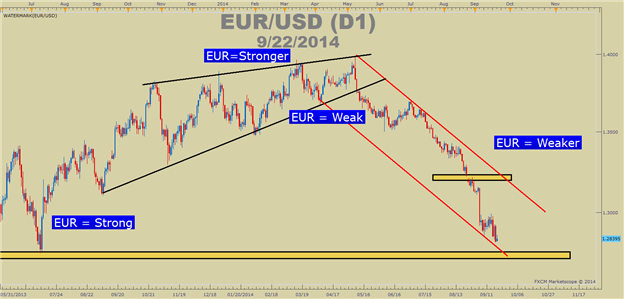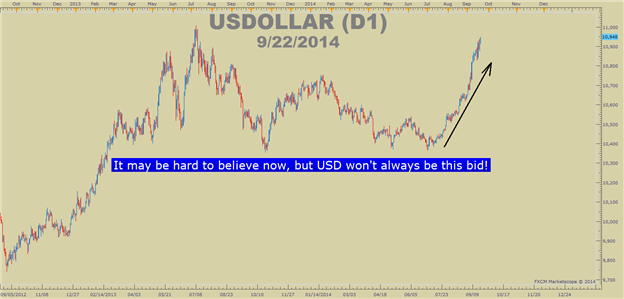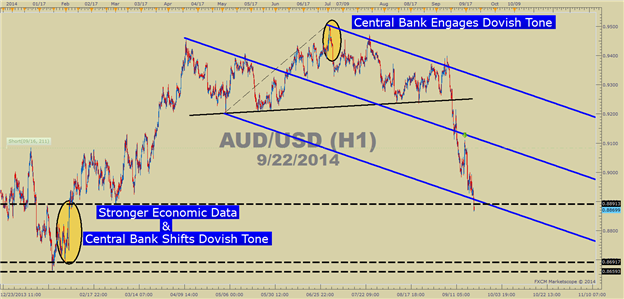Talking Points
-Don’t get married to a trade or currency
-Identifying the Next Likely FX Leader
-Know When That Has Failed
“If you cannot make money out of the leading active issues, you are not going to make money out of the market as a whole.”
“The leaders of today may not be the leaders of tomorrow.”
Jesse Livermore
Trading is simple but it isn’t easy. The simplicity is that trading often involves finding a strong currency via an uptrend on the charts and a weak currency via a downtrend on the charts. Once you’ve identified a strong currency and a weak currency, you can buy the strong against the weak until the trend ends. However, when that trend ends, it’s easy to become confused as to the next currency to focus on. This article will work out a framework to help you anticipate what currency may be next so that you can enter trades with a strong risk: reward ratio.
Please click HERE to join my distribution list
Don’t Get Married To a Trade or Currency

Presented by FXCM’s Marketscope Charts
Traders can run into difficultly when a trade that was a sure thing is no longer performing like it once did, yet they’re trying to squeeze a few more pips out of it. If the trader has stayed in the trade or continues to enter short-term trades that start to show more losses it could be that the trend has changed and could be just getting started. As you can see above, the Euro started in an uptrend from 1.2750, the 2013 low, up to a high in early May ’14 of 1.3992 and due to recent ECB action, only a few monthly later, we’re back near the 2013 low of 1.2750 and could easily surpass that low.
Bottom Line: Like the Euro in early 2014, what was once the leader doesn’t always remain the leader so you need to be able to have a flexible outlook and be ready to look for another trade when the leader is dethroned.
Identifying the Next Likely FX Leader

Presented by FXCM’s Marketscope Charts
Many traders know that currencies can flip from strong to weak. However, they’re not sure where to look for the currency that could soon become the new strongest currency. It’s important to know that there is no guarantee but we can definitely find with probable cause what can become the next leader in FX.
See Also: How To Find FX Trades with a Larger View of the Global Economy
The first place you can look when identifying the next likely big mover is to look for the next strongest currency. Another way to state this is a currency that is trending higher against all other currencies except the current leader. As of the time of this article, the British Pound meets this requirement. The GBP is up vs. the EUR, JPY, AUD, and other currencies but not the USD as the USD is the leader. Should the USD begin to weaken, the next strongest currency could become the British Pound.
Learn Forex: AUD has recently flipped from strongest to weakest among G10 FX

Presented by FXCM’s Marketscope Charts
The next place you can look is a developing fundamental story that hasn’t been priced into the market yet. A fundamental approach means a central bank move or a series of news events that begin to show weakness in a strong currency or strength in a weak currency. In early 2014, the very weak AUDUSD had a case of both stronger economic data and a central bank that was no longer talking down a currency.
Now that you're armed with a method of identifying the next potential big mover, feel free to try this information out on a FREE Forex Demo Account with access to multiple markets.
Know When That Idea Has Failed
This article is built around the concept that you can do a little homework to find what can become the next strongest currency. As the opening quote states, the leaders of today are not likely the leaders of tomorrow so it’s a worthy practice as a trader to find what could be the next leader. However, because we’re putting money at risk, we need to know when we’re wrong and the market has not chosen the currency we have as the next strongest currency.
It’s important to have a short leash on a new trade idea. Because you’re trying to get in early, you have very little proof and should take counter-hypothesis price action seriously and not be afraid of closing out the trade with a small loss. I establish a prior low in an uptrend as a support point that shouldn’t break if this new currency will be the next leader. Similarly, I’ll establish a prior high in a downtrend as a resistance point that should not break if something is to continue its momentum. If either level that I establish breaks, I’m out of the trade because no indicator or belief tops price action.
Sell Also:
How to Trade with Price Action, Part 1
How to Trade with Price Action, Part 2
Happy Trading!
---Written by Tyler Yell, Trading Instructor
To contact Tyler, email tyell@dailyfx.com
To be added to Tyler's e-mail distribution list, please click here
Tyler is available on Twitter @ ForexYell
Become a Smarter Trader Today
Claim your FREE universal membership to DailyFX Internet Courses & save yourself hours in figuring out what FOREX trading is all about.
You'll get this FREE 20 minute “New to FX” course presented by DailyFX Education. In the course, you will learn about the basics of a FOREX transaction, what leverage is, and how to determine an appropriate amount of leverage for your trading.




